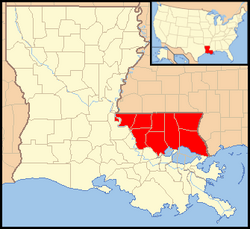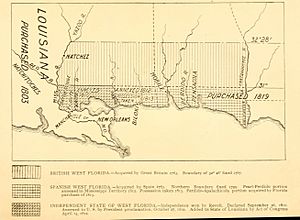Republic of West Florida facts for kids
Quick facts for kids
State of Florida
|
|||||||||||||
|---|---|---|---|---|---|---|---|---|---|---|---|---|---|
| 1810 | |||||||||||||
|
Flag
|
|||||||||||||
 |
|||||||||||||
| Status | Unrecognized state | ||||||||||||
| Capital | St. Francisville | ||||||||||||
| Government | Republic | ||||||||||||
| Governor | |||||||||||||
|
• 1810
|
Fulwar Skipwith | ||||||||||||
| Legislature | Senate and House of Representatives | ||||||||||||
| Historical era | U.S. westward expansion | ||||||||||||
|
• Rebel capture of Fort San Carlos at Baton Rouge
|
September 23, 1810 | ||||||||||||
|
• Declaration of independence from Spain
|
September 26, 1810 | ||||||||||||
|
• Madison proclaims "possession should be taken"; sends Claiborne to do so
|
October 27, 1810 | ||||||||||||
|
• St. Francisville acquiesces to U.S. Army
|
December 6, 1810 | ||||||||||||
|
• Surrender of Baton Rouge to U.S. Army
|
December 10, 1810 | ||||||||||||
|
|||||||||||||
| Today part of | United States ∟ Louisiana On July 17, 1821, Spain's governor of its West Florida province formally delivered it to U.S. General Andrew Jackson under the Adams–Onís Treaty. |
||||||||||||
The Republic of West Florida, officially called the State of Florida, was a small country that existed for about two and a half months in 1810. It was located in the western part of what was then Spanish West Florida. The United States took control of it later in 1810, and it became part of Louisiana.
Contents
Where Was the Republic of West Florida Located?
The Republic of West Florida was located south of the 31st parallel north. This line is a geographic marker. It was east of the Mississippi River. To the north of the Iberville River, Amite River, Lake Maurepas, Pass Manchac, Lake Pontchartrain, and the Rigolets. The Pearl River formed its eastern border.
Even though it was called "West Florida," none of this short-lived republic was in the modern state of Florida. It was entirely within what is now Louisiana.
Louisiana Parishes That Were Part of West Florida
Several areas in Louisiana today were once part of the Republic of West Florida. These are known as the Florida Parishes. They include:
- East Baton Rouge Parish
- East Feliciana Parish
- Livingston Parish
- St. Helena Parish
- St. Tammany Parish
- Tangipahoa Parish
- Washington Parish
- West Feliciana Parish
The republic also tried to take control of the Mobile District. This area included parts of present-day Mississippi and Alabama. However, a military group led by Reuben Kemper failed to capture it. These areas stayed under Spanish control until 1811 (Mississippi part) and 1813 (Alabama part).
The Baton Rouge District
The parishes of East Baton Rouge, East Feliciana, St. Tammany, Tangipahoa, and West Feliciana formed an area called the Baton Rouge District. This district was taken over by the United States in 1810.
A Brief History of West Florida
Before 1762, France owned the land west of the Perdido River. This was part of their large territory called La Louisiane. In 1762, France secretly gave all its lands west of the Mississippi River and the Isle of New Orleans to Spain.
After the Seven Years' War in 1763, France gave its remaining lands east of the Mississippi River to Great Britain. Spain also gave its Florida territory to Britain.
Twenty years later, after the American Revolutionary War in 1783, Spain got both East and West Florida back from Great Britain. The United States and Spain then had long talks about the northern border of West Florida. They finally agreed on it in 1795 with Pinckney's Treaty.
In 1800, under pressure from Napoleon of France, Spain gave Louisiana and New Orleans back to France. This agreement did not include West Florida. In 1803, France then sold Louisiana and New Orleans to the United States in what is known as the Louisiana Purchase.
The U.S. claimed that West Florida was part of this purchase. Spain disagreed, saying they had controlled West Florida separately since 1783.
Why Did People Want Independence?
Many Americans moved into West Florida in the early 1800s. The population in the Baton Rouge District was mostly Anglo-American. Some were land speculators who hoped to make money if the territory joined the U.S.
The U.S. wanted to control all the land east of the Mississippi River. This would help with trade and solve border problems. West Florida was important because it was between the U.S. Territory of Orleans and Mississippi Territory.
From June to September 1810, people who were unhappy with Spanish rule held secret meetings. They also had three public meetings in the Baton Rouge District. These meetings led to the West Florida rebellion and the creation of the independent Republic of West Florida. Its capital was St. Francisville.
The West Florida Rebellion
Early on September 23, 1810, armed rebels attacked Fort San Carlos in Baton Rouge. They killed two Spanish soldiers and took control of the area. The rebels raised the flag of their new republic. It was a single white star on a blue background. Melissa Johnson, the wife of Major Isaac Johnson, made the flag. This flag looked similar to the "Bonnie Blue Flag" used later in the American Civil War.
After this successful attack, led by Philemon Thomas, the rebels planned to take Mobile and Pensacola from the Spanish. They wanted to add these areas to their new republic. However, an attempt to capture Mobile led by Reuben Kemper failed.
The United States Steps In
U.S. President James Madison wanted to take over the West Florida district quickly. He feared it might fall into unfriendly hands, as many people there had once been British. Madison issued a proclamation on October 27, 1810, stating that the U.S. would take possession of West Florida.
Not everyone supported the rebellion. There were groups who favored Spain, groups who wanted to join the U.S., and groups who wanted West Florida to remain independent. This led to some conflict within the region. The group that wanted independence created a constitution in October. They also formed an army under General Philemon Thomas to stop opposition.
On November 7, Fulwar Skipwith was elected as the first and only governor of the Republic of West Florida. He also had a Senate and House of Representatives. Skipwith's inauguration was on November 29.
However, U.S. officials, including William C. C. Claiborne, the military governor of Orleans Territory, were already moving to take control. On December 6, 1810, Claiborne's forces entered St. Francisville. On December 10, 1810, they entered Baton Rouge.
Governor Skipwith and the West Florida legislature eventually agreed to accept the U.S. takeover. On December 10, 1810, the soldiers in the fort at Baton Rouge marched out. They stacked their weapons and saluted the West Florida flag as it was lowered for the last time.
Skipwith later said he was grateful for the U.S. intervention. However, he believed the U.S. should have recognized West Florida as an independent state before taking it over.
The U.S. Congress passed a resolution on January 15, 1811, to temporarily occupy the area. Spain did not officially give up its claim to West Florida until 1819, with the signing of the Adams–Onís Treaty.
Important Documents and Leaders
The Constitution of the Republic of West Florida was very similar to the United States Constitution. It divided the government into three parts: executive (governor), judicial (courts), and legislative (Senate and House of Representatives).
Fulwar Skipwith, the governor, was a cotton planter. He had worked as a diplomat for the U.S. in France and helped with the Louisiana Purchase. In his first speech as governor, Skipwith hinted that West Florida might eventually join the United States.
The marching song of the West Floridian army showed their love for freedom:
West Floriday, that lovely nation,
Free from king and tyranny,
Thru' the world shall be respected,
For her true love of Liberty.
How the United States Took Over West Florida
The United States did not officially recognize the Republic of West Florida as an independent country. On October 27, 1810, President James Madison announced that the U.S. would take possession of it. He argued that it was part of the Louisiana Purchase.
William C. C. Claiborne, the military governor of Orleans Territory, was sent to take control. The West Florida government did not want to be annexed without conditions. Governor Skipwith even said he and his men would "surround the Flag-Staff and die in its defense."
However, Claiborne entered St. Francisville with U.S. Army troops on December 6, 1810. He then entered Baton Rouge on December 10, 1810. After Claiborne refused to recognize the West Florida government, Skipwith and the legislature agreed to accept the U.S. takeover.
The Mobile District, which is now part of Mississippi and Alabama, remained under Spanish control for a while longer. In 1812, the U.S. assigned the part of West Florida east of the Pearl River to the Mississippi Territory. In April 1813, U.S. General James Wilkinson sailed to Mobile and received the surrender of the Spanish commander there.
West Florida Today
In the U.S. state of Louisiana, the areas that were once part of the Republic of West Florida are now known as the Florida Parishes. This name recognizes their history as a short-lived independent state and their connection to the larger colonial province of West Florida.
See also
 In Spanish: República de Florida Occidental para niños
In Spanish: República de Florida Occidental para niños



